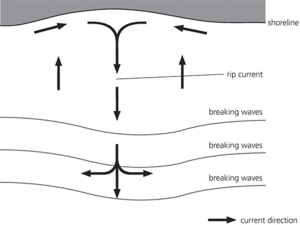Strong, narrow current usually of short duration, flowing seaward from the shore. The presence of a rip current can be detected as a visible band of agitated water flowing seawards, usually as a gap in the line of the incoming waves. Rip currents mark the swift return movement of water piled up on the shore by incoming waves and onshore winds.

Rip current
A strong current moving seawards in the near-shore zone. Munk (1949) Ann. NY Acad. Sci. 51, 3 suggested that rip currents were formed by onshore wave mass transport and that water piled up against the beach, which provided a hydraulic head for a rip current (an offshore return flow). Brander and Short (2001) J. Coast. Res. 17, 2 explain velocities in a rip channel by the continuity equation, in which the discharge out of the rip channel is equal to incoming wave-induced transport over the transverse bar. See also MacMahan et al. (2005) Marine Geol. 218, 1–4.